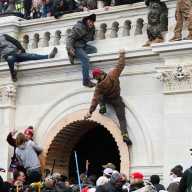The World Monuments Fund recently came a step closer to achieving its stated goal of “saving the world’s most treasured places,” when its proposal to preserve the New York State Pavilion – a tarnished but splendid remnant of the 1964 World’s Fair – was approved by the state’s Board for Historic Preservation.
A spot on the New York State Register of Historic Places means that the Pavilion’s iconic concrete and steel structures, still standing in Flushing Meadows-Corona Park 45 years after the culmination of the ’64 World’s Fair, now have access to preservation funding and could soon wind up on the National Register.
The city’s Parks Department said it recently applied for an Environmental Protection Fund grant to complete its structural study of the Pavilion’s Observation Towers and Tent of Tomorrow.
The Pavilion’s third component, the Theaterama, now known as Queens Theatre in the Park, has twice been renovated in the past two decades.
According to the state Office of Parks, Recreation and Historic Preservation, the Pavilion became one of 90,000 structures on the State Register because it met all four of the Preservation Board’s criteria: it has an association with events and history (the ’64 Fair); an association with people in history (it was designed by architect Philip Johnson and commissioned by city planner Robert Moses and then-Governor Nelson Rockefeller); and it boasts architectural and archeological value and distinction.
The board, which unanimously approved the Pavilion, grants state landmark status to around 30 structures each year, a spokesperson said.
In its proposal, which was approved on Tuesday, September 15, the private World Monuments Fund – supported in its effort by the city’s Parks Department – cited the Pavilion’s “exceptional significance as a rare survivor” of a breed of World’s Fair buildings that were not built to last.
Despite its cultural significance and the engineering feat it still recalls, the Pavilion’s structural steel is coated in rust and peeling paint – a far cry from its days as a centerpiece at the Fair.
In hopes of restoring the structures to their original glory, preservation groups and nostalgic Queens expatriates alike penned letters to the Historic Preservation Field Services Bureau, in support of their beloved Pavilion.
Wayne E. Bretl, of Grayslake Illinois, assured the board, “There are people all over the country and perhaps the world who are familiar with this unique building, those who saw it in its original glory, and even those who never had the chance, but have been captivated by its design and iconic style.”
In a letter that heralded New York City as home to many “interesting and recognizable landmarks,” Trey Callaway, a West Coast-based producer of the TV series CSI:NY, called Flushing Meadows “a one-of-a-kind place.”
The park and specifically the Pavilion, Callaway noted, maintain “the interest, attention and adoration of past fair attendants, current park patrons, and distant audiences everywhere – the New York State Pavilion deserves to be preserved for many generation to come.”































